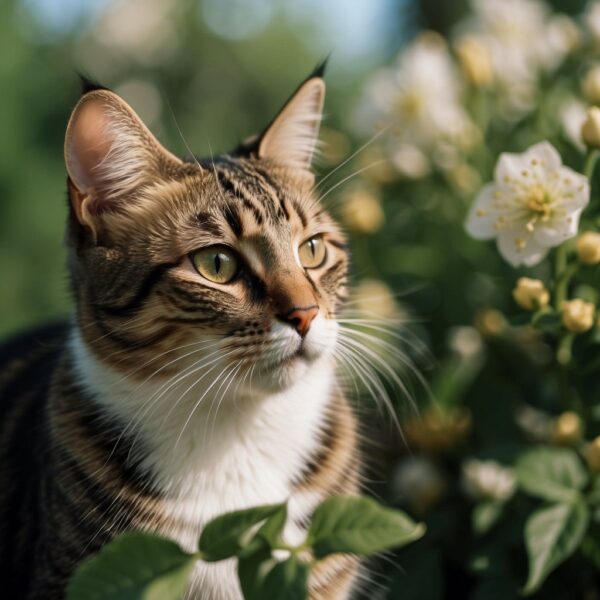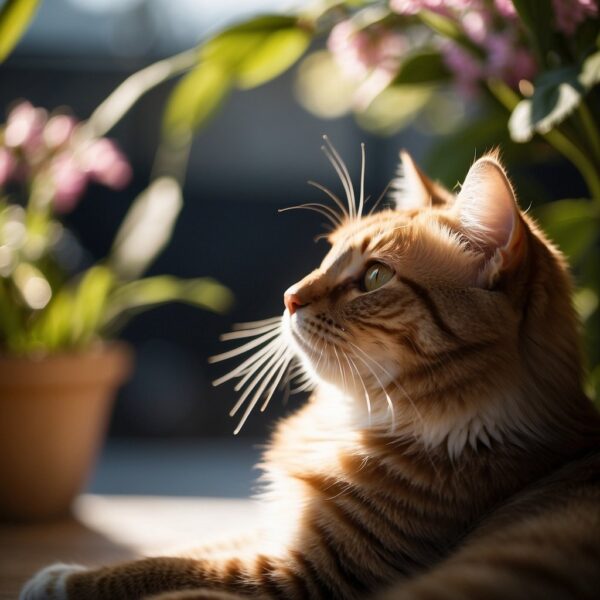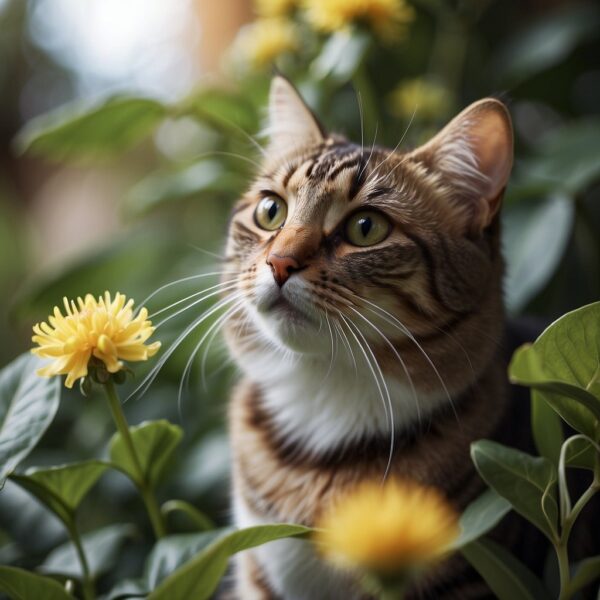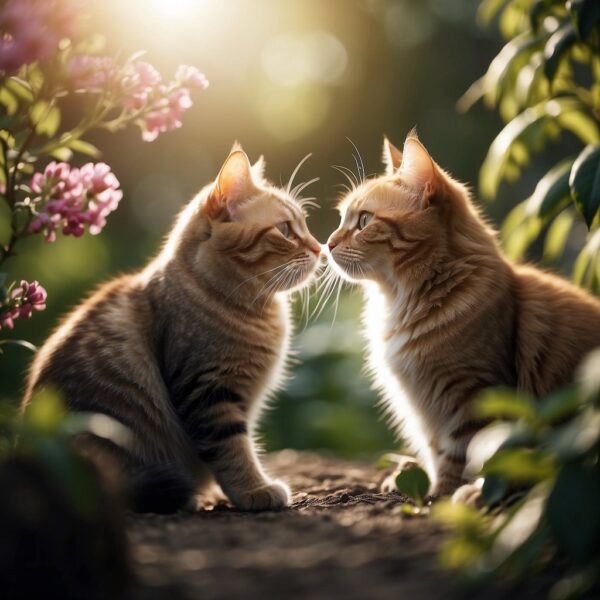
Cats and Honeysuckle: The Attraction and Effects
Cats are known for their complex behaviors and responses to various stimuli, with catnip being the most famous substance that elicits a notable reaction. However, an alternative to catnip that is gaining attention is honeysuckle, particularly for its effectiveness in stimulating cats that otherwise show no interest in catnip. Unlike catnip, which usually affects cats post-puberty, honeysuckle can appeal to cats at a younger age. It emits a strong aroma that might be more enticing to cats, possibly due to the presence of different chemical compounds that interact with a cat’s senses in a unique way.
Honeysuckle is believed to exert a calming effect on cats, which has led to its use in therapies for addressing conditions such as stress and anxiety in felines. While many cats enjoy safely, cat parents should be educated on the potential risks. As with any plant or herb, there is a possibility of an allergic reaction, and the consumption of large quantities could lead to digestive issues. Awareness is crucial when introducing honeysuckle to ensure a positive experience for the cat.
Key Takeaways
- Honeysuckle offers an alternative to catnip and can affect cats, including younger ones.
- The plant’s strong aroma and therapeutic properties are appealing and calming to cats.
- Responsible usage of honeysuckle is important due to potential risks like allergies or digestive upset.

Understanding Cats and Honeysuckle
In the interplay between cats and honeysuckle, it is essential to comprehend the plant’s allure, the science behind feline olfaction, and the genetic factors influencing a cat’s behavior to specific scents.
Cat’s Attraction to Plants
Cats exhibit a diverse range of responses to plants, with honeysuckle often eliciting a noticeable reaction. Unlike catnip (Nepeta cataria), which contains nepetalactone, honeysuckle’s actinidine is the enticing component causing similar, but not identical, behavioral effects. While some cats are indifferent, others may display increased affection or playful behavior upon exposure to the scent of honeysuckle.
Science of Scent in Felines
Cats possess a highly developed sense of smell, with their olfactory receptors tuned to detect specific volatile compounds. Essential oils in plants like honeysuckle, silvervine (Actinidia polygama), and valeriana officinalis carry distinctive scents that can stimulate a sensory reaction. This interaction primarily occurs through a mechanism of action involving the olfactory system, which significantly influences feline interaction with plants.
Genetics and Cat Behavior
Research indicates that the response to scents like those produced by honeysuckle and catnip is a genetically inherited behavior. The presence of a genetic variation influences whether a cat will experience the catnip response, with an estimated two-thirds of cats being responsive. The likelihood of a reaction to honeysuckle and other similar substances may likewise be tied to genetic predisposition, affecting a cat’s individual personality and behavioral traits.

Honeysuckle and Its Effects on Cats
Honeysuckle, particularly the Lonicera tatarica species, has distinct effects on cats, such as eliciting playfulness similar to catnip. Here, we discuss the varieties, responses, safety aspects, and use of honeysuckle wood in cat care.
Honeysuckle Varieties
The Lonicera genus comprises around 180 species, but it is the Lonicera tatarica, also known as tartarian honeysuckle, that is known to affect cat behavior. While flowers, leaves, and berries exist on these plants, most effects are attributed to the woody parts.
Behavioral Responses to Honeysuckle
Cats exposed to certain types of this plant exhibit uninhibited playfulness. They may pounce, race, and roll as they engage with toys. Some cats may become more mellow while others may exhibit slightly aggressive behaviors due to overstimulation.
Physical Reactions and Safety
Though not typically considered toxic, it’s essential to monitor cats for any allergic reactions or unusual symptoms that could indicate sensitivity. If a cat shows signs of poisoning, such as excessive salivation or vomiting, immediate veterinary care is required. Ensure that any plant material is safe and non-toxic before offering it to your cat.

Alternative Cat Attractants
Cat parents often seek ways to provide olfactory enrichment for their pets. This section explores effective plant-based attractants, non-plant aromatics, and toys that can serve as alternatives or complements to catnip for feline enjoyment and stimulation.
Efficacy of Catnip and Alternatives
Catnip, scientifically known as Nepeta cataria, is renowned for its effect on cats due to the active compound, nepetalactone. However, not all cats respond to catnip. In those instances, alternatives such as silvervine (Actinidia polygama) and valerian root (Valeriana officinalis) can be more appealing. Silvervine contains the compound dihydroactinidiolide, which many cats find irresistible. Compared to catnip, valerian root possesses a different blend of compounds, including actinidine and valerenic acid, which can also provide a calming effect on felines.
- Cat Attracting Compounds:
- Catnip: Nepetalactone
- Silvervine: Dihydroactinidiolide, Actinidine
- Valerian Root: Valerenic acid
Toys and Olfactory Enrichment
Toys infused with cat-attracting scents offer both mental stimulation and physical exercise. A variety of toys, such as mice, play mats, and cushions, can be enhanced with scents to encourage play. Additionally, sprays containing cat-attracting compounds can be applied to toys, offering a method of olfactory enrichment without the mess of loose herbs.
- Toy Examples:
- Infused toys: Mice, play mats, body pillows
- Olfactory Sprays: Used on toys or bedding for scent-based enrichment
By using these alternatives and enrichment tools, cat parents can provide stimulating environments that cater to their feline’s unique sensory preferences.

Cats and Honeysuckle: Frequently Asked Questions
In this section, frequently asked questions about the interaction between cats and this plant are addressed, providing insights into safety, attraction, and the effects of honeysuckle on cats.
Are honeysuckles safe for cats to interact with?
Cats can generally interact safely with honeysuckle, particularly when it is used in products designed for cats. However, guardians should monitor their cats to prevent ingestion of large quantities which could cause digestive upset.
Why are cats attracted to honeysuckle?
Cats are attracted to honeysuckle due to a chemical similar to the one found in catnip, which can trigger a playful and pleasure-inducing response in some cats, even those not affected by catnip.
What are the effects of cats ingesting honeysuckle?
Ingestion of small amounts typically does not harm cats and may result in a temporary euphoric reaction. However, consuming large amounts can lead to gastrointestinal upset, so moderation is key.
Do honeysuckle products exist specifically designed for cats?
Yes, there are products on the market that incorporate honeysuckle for cats. These include toys and sprays that are specifically designed to be safe and appealing for feline play.
Is there a risk of honeysuckle oil causing toxicity in cats?
Honeysuckle oil, concentrated and essential oils in particular, could be toxic to cats if used improperly. It is advised to avoid exposing cats to concentrated oil to prevent the risk of toxicity.
How does honeysuckle compare to other cat attractants like silvervine or valerian?
Honeysuckle is one of several natural substances that can attract cats. While some cats may be unaffected by catnip, they may have a positive reaction to honeysuckle, silvervine, or valerian, each offering a unique scent and effect.